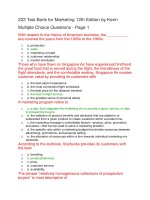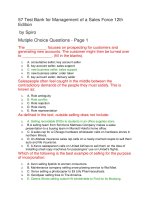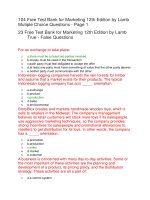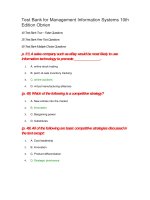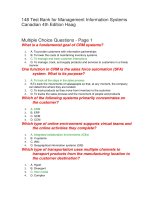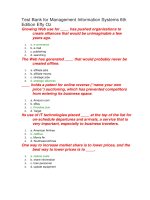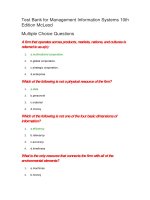94 test bank for management 12th edition robbins
Bạn đang xem bản rút gọn của tài liệu. Xem và tải ngay bản đầy đủ của tài liệu tại đây (172 KB, 38 trang )
94 Test Bank for Management 12th Edition Robbins
Multiple Choice Questions - Page 1
According to the symbolic view, managers have a(n)
________ effect on substantive organizational
outcomes.
1.
2.
3.
4.
A) limited
B) extensive
C) influential
D) significant
Which of the following represents the two views of
managerial impact on the success or failure of the
organization?
1.
2.
3.
4.
A) omnipotent and symbolic
B) omnipotent and reflective
C) symbolic and interactive
D) reflective and interactive
D&B Designs has been in the landscape design business in
Pleasantville for the past twenty years. As the "first
mover" in the market, the company has built a strong
market share over the years and is the best-known firm
in the area. The company strength increased steadily,
and now stands at fifty employees. Which of the
following, if true, would make the company's business
environment more uncertain?
1.
A) Homeowners in the area take pride in their gardens and are avid do-it-yourself
gardeners.
2. B) Demand for landscaping services dips every autumn and winter.
3.
4.
C) A long-time competitor quit the landscape design business last year.
D) Zoning laws in the area change as each new city council comes into power.
Which of the following most accurately reflects the
difference between strong cultures and weak
cultures?
1.
A) Strong cultures tend to encourage employees to try new approaches to
changing conditions, while weak cultures do not.
2. B) In strong cultures, organizational values are held by top management, while in
weak cultures, values are diffused throughout the organization.
3. C) Strong cultures have less of an influence on employee behavior than do weak
cultures.
4. D) Company values are more deeply held and widely shared in strong cultures
than in weak cultures.
________ has been described as the shared values,
principles, traditions, and ways of doing things that
influence the way organization members act.
1.
2.
3.
4.
A) Corporate hierarchy
B) Business configuration
C) Organization culture
D) Industrial psychology
The current dominant assumption in management theory
suggests that ________.
1.
A) an organization's success or failure is due to external forces outside managers'
control
2. B) managers' roles are increasingly becoming peripheral and staff manage their
own areas of expertise
3. C) managers are directly responsible for an organization's success or failure
4. D) managers cannot significantly affect an organization's performance because
they constrained by the abilities of their employees
Which of the following factors is a sociocultural component
of an organization's external environment?
1.
2.
3.
4.
A) education level
B) political stability
C) behavior patterns
D) family composition
Which of the following are the two dimensions of
environmental uncertainty?
1.
2.
3.
4.
A) degree of change and degree of complexity
B) degree of change and degree of volume
C) degree of complexity and degree of impact
D) degree of impact and degree of timing
If the components in an organization's environment exhibit
minimal change, such an environment is said to be
________.
1.
2.
3.
4.
A) volatile
B) dynamic
C) stable
D) active
The soccer league in England is notorious for the number of
team managers fired over the course of a single
season, which stands at no fewer than eight managers
on average, owing to poor team form and
consequently, poor results. It is evident from this
information that the league endorses a(n) ________
view of management.
1.
2.
3.
4.
A) symbolic
B) omnipotent
C) laissez-faire
D) democratic
Which of the following statements is true of dynamic and
complex environments?
1.
2.
3.
A) They are characterized by a high degree of predictability of change.
B) There are usually few components in such environments.
C) A high need for sophisticated knowledge of components exists in such
environments.
4. D) The components in such environments are somewhat similar, but are
continually changing.
The omnipotent view of management states that
________.
1.
A) managers' roles are peripheral and staff manage their own areas of the
business
2. B) managers are directly responsible for an organization's success or failure
3. C) managers should allow employees to take part in decision making
4. D) managers have little or no responsibility for an organization's success or failure
Which of the following most accurately reflects the symbolic
view of management?
1.
2.
A) Managers are directly responsible for an organization's success or failure.
B) Managers have to ensure that every obstacle is overcome on the way to
achieving the organization's goals.
3. C) External forces are responsible for an organization's success or failure.
4. D) Employees are directly responsible for an organization's success or failure.
Which of the following factors is an economic component of
an organization's external environment?
1.
2.
3.
4.
A) family composition
B) education level
C) disposable income
D) geographic location
The ________ view of management is consistent with the
stereotypical picture of the take-charge business
executive who can overcome any obstacle in carrying
out the organization's objectives.
1.
2.
3.
4.
A) omnipotent
B) symbolic
C) democratic
D) laissez-faire
The grassroots slogan of the Occupy movement, "We are the
99%", refers to ________.
1.
2.
3.
A) social discontent over the slow recovery of global economies
B) fear of chronic fiscal imbalances in government sectors
C) societal acceptance of U.S. values and ways of doing things
4.
D) the sensitivities surrounding severe income disparities, particularly in the United
States
The symbolic view of management is based upon the belief
that managers symbolize ________.
1.
2.
A) control and influence in developing plans and making decisions
B) every aspect of an organization's performance, from the top level to the
operational level
3. C) the fluctuating fortunes of the organization as they alternate between profits
and losses
4. D) the take-charge executive who overcomes any obstacle to see that the
organization achieves its goals
Which of the following statements highlights the shared
aspect of culture?
1.
A) Organizational culture is concerned with how members perceive the culture and
describe it, not with whether they like it.
2. B) Organizational culture is not something that can be physically touched or seen,
but employees perceive it on the basis of what they experience within the
organization.
3. C) The original source of the culture of an organization reflects the vision of the
organizaton's founders.
4. D) Even though individuals may have different backgrounds or work at different
organizational levels, they tend to describe the organization's culture in similar
terms.
Grayson's has been in the publishing business for fifty
years. In the past two years, the company has noticed
that book sales have been tapering off, as more and
more readers prefer formats they can read on ereaders or smartphones. Grayson's needs to analyze
the changes in the environment so that it can change
its business strategies and meet the needs of the new
market. It commissions a market research firm to
collect information about the recent changes in
reading habits. Which of the following
questions
1.
2.
3.
4.
A) How many books does an individual customer buy in a month?
B) What types of books do customers buy in traditional form?
C) Which format is more reader-friendly, e-books or traditional books?
D) How much do readers spend on e-books in a month?
Which of the following is a characteristic of a dynamic
environment?
1.
2.
3.
4.
A) high level of predictability of changes in environmental conditions
B) few technological breakthroughs by current competitors
C) the presence of new competitors in the market
D) little activity by pressure groups to influence the organization
If the components of an organization's environment change
frequently, the organization is operating in a ________
environment.
1.
2.
3.
4.
A) stable
B) secure
C) dynamic
D) constant
Which of the following environments is characterized by the
highest level of environmental uncertainty?
1.
2.
3.
4.
A) a stable and complex environment
B) a dynamic and simple environment
C) a stable and simple environment
D) a dynamic and complex environment
Which of the following factors is a demographic component
of an organization's external environment?
1.
2.
3.
4.
A) lifestyles and behavior
B) political stability
C) geographic location
D) stock market fluctuations
In which of the following environments do managers in an
organization have the greatest influence on
organizational outcomes?
1.
2.
3.
4.
A) stable and complex environments
B) dynamic and simple environments
C) stable and simple environments
D) dynamic and complex environments
The economic environment affects the performance of an
organization, as was noted during the recent
recession. Which of the following factors is cited as
one of the causes of the recent recession triggered in
the home mortgage markets in the United
States?
1.
A) high interest rates on mortgages
2.
3.
4.
B) massive global liquidity
C) lack of leverageability for business borrowers
D) difficulty in securing housing credit
________ is/are called the iGeneration, because they've
grown up with technology that customizes everything
to the individual.
1.
2.
3.
4.
A) Post-Millenials
B) The Silent Generation
C) Baby Boomers
D) Gen Y-ers
Which of the following groups includes individuals who were
born between the years 1946-1964?
1.
2.
3.
4.
A) the Silent Generation
B) the Gen Y-ers
C) the Baby Boomers
D) Post-Millenials
Which of the following is NOT true about the environmental
complexity of an organization?
1.
2.
A) Environmental complexity increases as the number of competitors increases.
B) It is measured in terms of the knowledge an organization needs about its
environment.
3. C) Complexity decreases as the number of regulatory agencies increases.
4. D) It depends on the knowledge an organization has about the components of its
environment.
Elmo Research & Development has been going through a
rough patch lately. Turnover has been high and
employee morale is at an all-time low. Though
employees and competitors hold management
responsible for the decline, the CEO does not let the
managers go or change the management style. Which
of the following could explain this attitude?
1.
A) The CEO holds the omnipotent view of management, which believes that
external factors have a significant effect on performance outcomes.
2. B) As the organization has an autocratic management style, the employees are
responsible for organizational policies.
3. C) The organization has a participative management style and decisions are
guided by consensus.
4. D) The CEO holds the view that managers have only limited role in organization
success or failure.
The ________ component of an organization's external
environment is concerned with trends in population
characteristics such as age, race, gender, education
level, geographic location, income, and family
composition.
1.
2.
3.
4.
A) economic
B) political
C) demographic
D) sociocultural
The term ________ is used to collectively refer to any
constituencies in an organization's environment that
are affected by its decisions and actions.
1.
2.
3.
4.
A) competitors
B) shareholders
C) unions
D) stakeholders
Internal constraints that influence managers' decisions and
actions come from ________.
1.
2.
3.
4.
A) the attitudes of customers
B) the culture of the organization
C) the prevailing political conditions
D) the fluctuations in the stock market
63 Free Test Bank for Management 12th Edition
Robbins Multiple Choice Questions - Page 2
According to Swedish researcher Goran Ekvall, which of the
following is a characteristic found in an innovative
culture?
1.
2.
3.
4.
A) a serious outlook toward work
B) intolerance toward uncertainty or ambiguity
C) resolution of employee issues based on personal interest
D) freedom for employees to express opinions
If you were talking with Todd and asked him what the term
culture meant, he would reply that it is
________.
1.
2.
3.
4.
A) the formal rules of an organization
B) the nature of products/services offered by the company
C) the shared values and practices of the firm
D) a set of operational procedures for the company
Todd is concerned with the degree to which managers focus
on results rather than techniques and the processes
used to achieve those results. In other words, Todd is
concerned that the company will emphasize ________
over other dimensions of the organizational
culture.
1.
2.
3.
4.
A) stability
B) aggressiveness
C) attention to detail
D) outcome orientation
Which of the following guidelines should managers follow
while building a customer-responsive culture?
1.
A) precisely defining employees' normal job requirements and ensuring they
perform those actions alone
2. B) giving service-contact employees continual training on product knowledge,
listening, and other behavioral skills
3. C) designing jobs with rigid rules and procedure that employees should stick to in
order to satisfy customers
4. D) preserving the discretion to make day-to-day decisions on job-related activities
at the top level of management
Todd notices that management is very concerned with the
effects of outcomes on employees in the organization.
This means that the management emphasizes the
________ dimension of the organization's
culture.
1.
2.
3.
4.
A) stability
B) people orientation
C) aggressiveness
D) innovation and risk taking
Which of the following dimensions of organizational culture
refers to the degree to which organizational decisions
and actions emphasize maintaining the status
quo?
1.
2.
3.
4.
A) stability
B) attention to detail
C) innovation and risk taking
D) people orientation
Which of the following is most likely to have a highly
spiritual organizational culture?
1.
2.
3.
4.
A) a highly aggressive, competitive business
B) a company with high tolerance of employee expression
C) a business that focuses strictly on outcomes
D) a business that emphasizes centralized control
Which of the following is a characteristic found in spiritual
organizations?
1.
2.
3.
4.
A) focus on team development, rather than individual development
B) profit-oriented outlook towards all organizational activities
C) tolerance towards mistakes and openness with customers and employees
D) emphasis on controlling emotions and feelings
The area in which your office operates has been relatively
stable in terms of land prices and demand. However,
you have noticed that demand for housing in the area
usually spikes in summer. Which of the following best
describes your business environment?
1.
A) stable and simple
2.
3.
4.
B) dynamic and simple
C) stable and complex
D) dynamic and complex
Which of the following is a disadvantage of having a strong
organizational culture?
1.
2.
3.
4.
A) high employee turnover
B) decreased organizational performance
C) low loyalty towards the organization
D) inability to respond to changing conditions
________ is a process that helps new employees learn the
organization's way of doing things.
1.
2.
3.
4.
A) Externalization
B) Socialization
C) Deculturation
D) Transculturation
Imagine that the town to which your office caters sees a
sudden spurt in popularity. There has been a lot of
construction activity in the area and a number of
properties are being developed. The number of
customers has increased, and so have your
competitors. In this situation, what should you do to
reduce environmental uncertainty?
1.
2.
3.
4.
A) Restructure your organizational hierarchy to improve efficiency
B) Acquire or merge with one or more of your competitors
C) Maintain the status quo by keeping your business processes constant
D) Communicate the situation clearly to all your stakeholders
Which of the following is a criticism of spiritual
organizational cultures?
1.
2.
3.
4.
A) inhibition of employees' expressions and emotions
B) incompatibility between profits and spirituality
C) lack of openness with stakeholders such as customers and suppliers
D) absence of employee empowerment
If the mortgage interest rates increase, this would be an
example of changing ________ in your external
environment.
1.
2.
3.
4.
A) economic conditions
B) political conditions
C) sociocultural conditions
D) demographic conditions
Wendell notices that the company's top executives share a
belief that managers are directly responsible for the
organization's success or failure. This belief reflects
a(n) ________ view of management.
1.
2.
3.
4.
A) traditional
B) omnipotent
C) emblematic
D) symbolic
The term ________ refers to repetitive sequences of
activities that express and reinforce the important
values and goals of the organization.
1.
2.
3.
A) organizational culture
B) corporate rituals
C) business ethics
4.
D) employee mentoring
Which of the following is a characteristic of an organization
with a strong culture?
1.
A) management strives to delink shared values from behaviors as much as
possible
2. B) culture conveys consistent messages about what is important to the
organization
3. C) the core set of organizational values is zealously guarded by the management
4. D) emphasis is laid on the future of the organization, rather than acquainting
employees with company history or past heroes
The original source of an organization's culture usually
reflects ________.
1.
2.
3.
4.
A) the present conditions in which the organization functions
B) the composition of its productive workforce
C) the degree of success that the organization has achieved
D) the vision or mission of the organization's founder
Organizational ________ typically contain narratives about
significant events or people in the
organization.
1.
2.
3.
4.
A) stories
B) rituals
C) language
D) material artifacts
Workplace spirituality has become important in the
contemporary workplace because it ________.
1.
2.
3.
A) increases organizational efficiency
B) boosts company profits
C) gives employees a sense of purpose
4.
D) brings religion into business
Which of the following is an example of a corporate
ritual?
1.
A) Employees swapping stories about the company's history and past heroes who
have made significant contributions to the company.
2. B) Company executives using company-specific jargon or slogans intended to
inspire other employees to perform better.
3. C) Companies hosting annual parties to commemorate employee contributions
and reward outstanding performance.
4. D) The assortment of material artifacts that characterize an organization, including
the layout of its facilities, how its employees dress, and the types of automobiles
provided to top executives.
Which of the following would make Mary realize that the
company has a strong culture?
1.
2.
3.
4.
A) values are limited to the top management
B) culture sends contradictory messages about what is important
C) most employees are aware of company history
D) shared values and behaviors are not connected
Mary also found out that in order to build a strong new
culture, she should do all but which of the
following?
1.
2.
3.
4.
A) hire employees who fit in with the company's culture
B) develop socialization practices to build culture
C) encourage a high turnover rate among employees
D) have management make organizational values clear
An innovative organizational culture is characterized by all of
the following, EXCEPT ________.
1.
A) freedom
2.
3.
4.
B) conformity
C) debates
D) risk taking
Google has often been cited as a model for employee
satisfaction. Google takes extensive care to ensure
employees have the best available conditions to
perform, ranging from free snack bars, free massages,
innovation rooms, spas-on-site, and many more such
measures. Which dimension of organizational culture
is Google said to emphasize through such
measures?
1.
2.
3.
4.
A) stability
B) aggressiveness
C) people orientation
D) attention to detail
Which dimension of the organizational culture is workplace
spirituality most closely related to?
1.
2.
3.
4.
A) outcome-orientation
B) innovation and risk taking
C) attention to detail
D) people-orientation
A company whose managers focus on results, rather than
how results are achieved, most likely possesses a high
degree of ________.
1.
2.
3.
4.
A) people orientation
B) team orientation
C) outcome orientation
D) aggressiveness
A company that aims to develop a strong sense of purpose
through meaningful work has a(n) ________
organizational culture.
1.
2.
3.
4.
A) spiritual
B) authoritarian
C) profit-oriented
D) outcome-oriented
In an organization whose culture conveys a basic distrust of
employees, managers are more likely to use a(n)
________ leadership style.
1.
2.
3.
4.
A) participatory
B) democratic
C) authoritarian
D) laissez-faire
An organization's culture supports the belief that profits can
be increased by cost cutting and that the company's
best interests are served by achieving slow but steady
increases in quarterly earnings. What is the nature of
the programs that the organization's managers are
likely to follow?
1.
2.
3.
4.
A) short-term
B) risky
C) innovative
D) expansionary
Wendell interviews many middle-level managers and
discovers that they share a different view of
management. These individuals believe that external
factors constrain managers' influence over outcomes.
The mid-level managers have a(n) ________ view of
management.
1.
2.
3.
4.
A) traditional
B) omnipotent
C) standard
D) symbolic
True - False Questions
Organizations that emphasize workplace spirituality focus on
individual development.
1.
2.
True
False
The view of managers as omnipotent is consistent with the
stereotypical picture of the take-charge business
executive who can overcome any obstacle in carrying
out the organization's objectives.
1.
2.
True
False
In a "ready-aim-fire" culture, managers take action and then
analyze what has been done.
1.
2.
True
False
Environmental uncertainty looks at the number of
components in an organization's environment and the
extent of the knowledge that the organization has
about those components.
1.
2.
True
False
A dynamic and simple environment is characterized by the
greatest level of environmental uncertainty.
1.
2.
True
False
In strong organizational cultures, employees have little
knowledge of company history or heroes, what is
important is present performance.
1.
2.
True
False
Giving service-contact employees the discretion to make
day-to-day decisions on job-related activities is
instrumental in creating in a customer-responsive
culture.
1.
2.
True
False
A valid criticism of workplace spirituality is that secular
institutions, especially businesses, have no right to
impose spiritual values on employees, if spirituality
means bringing religion into the workplace.
1.
2.
True
False
Conditions of economic inequality illustrate how societal
attitudes can constrain managers' decisions and
actions.
1.
2.
True
False
The symbolic view of management impact is useful in
explaining the high turnover among sports coaches,
who can be considered the "managers" of their
teams.
1.
2.
True
False
In the symbolic view of management, managers are seen as
directly responsible for an organization's success or
failure.
1.
2.
True
False
Managers of high-performing companies tend to consider
the interests of the most profitable stakeholder groups
as they make decisions.
1.
2.
True
False
In order to develop an innovative organizational culture,
managers must minimize ambiguity and uncertainty
and discourage risk-taking.
1.
2.
True
False
Organizations help employees adapt to the culture through
socialization.
1.
2.
True
False
Spiritual organizations tend to be intolerant of employees
who commit mistakes.
1.
2.
True
False
Strong cultures have more influence on employees than do
weak cultures.
1.
2.
True
False
Corporate rituals are repetitive sequences of activities that
express and reinforce the key values of an
organization.
1.
2.
True
False
An organization's competitors and employees are
considered to be stakeholders who are affected by the
organization's decisions and actions.
1.
2.
True
False
A dynamic environment is characterized by the absence of
new competitors, few technological breakthroughs by
current competitors, and little activity by pressure
groups to influence the organization.
1.
2.
True
False
The shared aspect of culture implies that all employees in an
organization approve of the culture.
1.
2.
True
False
Organizations that subscribe to workplace spirituality
emphasize the importance of employees controlling
their expressions and emotions.
1.
2.
True
False
